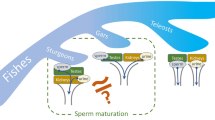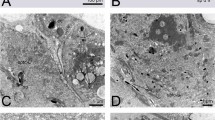Abstract
IN connexion with some work which Dr. Sylvia Wigoder and I are carrying out, it became necessary to re-examine the spermatogenesis of Cavia. By chilling the Da Fano fluid (5° C.) it was possible to get extremely good and unshrunken preparations. These rovealed a remarkable argentophile band on the ripe sperms (Fig. 1, PNB), which was easily traced back into the spermatid (Fig. 2, No. 13, PNG) in the form of a group of granules, which constituted in the later spermatid (Fig. 2, No. 14) a sort of coalescing network embracing the hinder part of the nucleus. This reminded me of similar structures already described in Saccocirrus (Q.J.M.S., 1922, and Fig. 2, Nos. 1 and 2, PNB) and in a number of pulmonate mollusca (ibid., 1919, and Fig. 2, Nos. 3 and 4, PNG, post-nuclear granules).
This is a preview of subscription content, access via your institution
Access options
Subscribe to this journal
Receive 51 print issues and online access
$199.00 per year
only $3.90 per issue
Buy this article
- Purchase on Springer Link
- Instant access to full article PDF
Prices may be subject to local taxes which are calculated during checkout
Similar content being viewed by others
Author information
Authors and Affiliations
Rights and permissions
About this article
Cite this article
GATENBY, J. The Recognition of a New Category of Structures in Spermatogenesis. Nature 122, 504–505 (1928). https://doi.org/10.1038/122504b0
Issue Date:
DOI: https://doi.org/10.1038/122504b0
This article is cited by
-
Spermatogenesis ofLaccotrephes griseus, Guer
Proceedings / Indian Academy of Sciences (1945)
Comments
By submitting a comment you agree to abide by our Terms and Community Guidelines. If you find something abusive or that does not comply with our terms or guidelines please flag it as inappropriate.



